Noble Learners is an India-based online Tutoring Website for providing the best Maths tutors for the Canadian curriculum. Keeping in view this factor, we believe in one-to-one tutoring services. Every student has special needs that cannot be met in the group classes. Each student has their strengths and weaknesses; thus, we provide specialized tutoring. If you are looking for Online Tutoring for Canada from India, then you are at the best place.
Why to choose Noble Learners?
-
Expert Tutors From India
At Noble Learners, we pride ourselves on having a team of expert tutors who are not only well-qualified but also possess extensive teaching experience. Our tutors are well-versed in the Canadian curriculum, offering tailored guidance to students across Canada. This ensures that students get the best online tutoring experience from highly skilled professionals in India.
-
One-One-Tutoring
We understand that every student has unique learning needs. That’s why Noble Learners focuses on personalized, one-on-one tutoring. Our tutors act as mentors, offering individualized attention to help students achieve their academic goals. Many students have successfully improved their grades and excelled in exams with our personalized approach.
-
Flexible Timings
At Noble Learners, flexibility is key. We offer tutoring sessions at times that are convenient for the student, making it easier to balance school, extracurriculars, and other commitments. No matter your schedule, our tutors are available to accommodate your needs.
-
Live Sessions Via Zoom
All of our sessions are live, one-on-one classes conducted via Zoom. Unlike other platforms that offer pre-recorded courses, we believe in real-time learning. This ensures that students can get their doubts clarified instantly, improving their understanding. Our tutors are dedicated to addressing every student’s questions and providing comprehensive explanations.
-
Free Demo (30-Minutes)
Choosing the right tutor is crucial to academic success. That’s why we offer a free 30-minute demo class, giving students the opportunity to evaluate the tutor before making a decision. This trial session ensures that the student feels comfortable with the teaching style and content. After the first demo, you can even request a second free demo with another tutor if needed.
-
More than 50 teachers to choose from
With over 50 experienced tutors to choose from, Noble Learners offers a variety of options to ensure the perfect match for each student’s needs. If you're not satisfied with your first demo, you can explore a second demo with another expert. Please note that only two demo classes are free, and subsequent demo sessions may incur a charge.

We also Provide Social Studies, English Other Subject Tutoring
Grade 1 Math Syllabus for Canada: Online Tutoring for Canada from India.
When it comes to providing the best educational support for young learners, Noble Learners is dedicated to offering online tutoring for Canada from India. We specialize in aligning our lessons with the Canadian curriculum, ensuring that students receive comprehensive guidance tailored to their specific academic needs. Our experienced tutors use interactive, one-on-one sessions to help students grasp key concepts, laying a strong foundation for their future studies.
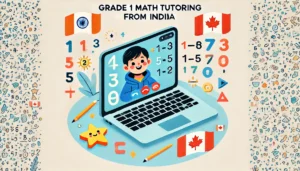
Grade 1 Math Syllabus (Canada)
Number Sense and Numeration
- Understanding numbers up to 50
- Counting by 1s, 2s, 5s, and 10s
- Comparing and ordering numbers
- Introduction to addition and subtraction (single digits)
- Simple problem-solving involving addition and subtraction
Geometry and Spatial Sense
- Identifying and describing common 2D shapes (circle, triangle, square, rectangle)
- Recognizing 3D shapes (cube, cone, cylinder)
- Understanding concepts of symmetry and simple transformations like slides and flips
- Describing the position and movement of objects
Measurement
- Comparing lengths, heights, and distances using non-standard units (e.g., using hands or feet to measure)
- Understanding the concept of time (days, weeks, months) and reading time to the hour
- Introduction to simple units of measurement (centimeters, meters)
- Understanding the concept of weight (lighter, heavier)
Patterning and Algebra
- Identifying and creating simple patterns (AB, ABC)
- Extending and predicting patterns using objects, shapes, and numbers
- Understanding the concept of equality (e.g., 2 + 2 = 4)
Data Management and Probability
- Sorting and organizing objects into categories
- Reading and interpreting simple graphs (e.g., pictographs)
- Conducting simple surveys (e.g., favorite color, number of pets)
Grade 2 Math Syllabus for Canada: Online Tutoring for Canada from India
At Noble Learners, we are committed to providing top-quality online tutoring for Canada from India. Our expert tutors are experienced in the Canadian curriculum, ensuring that each student receives personalized and comprehensive instruction tailored to their specific needs. With a focus on building strong foundational skills, our one-on-one tutoring sessions are designed to help Grade 2 students excel in mathematics and develop a lifelong love for learning.
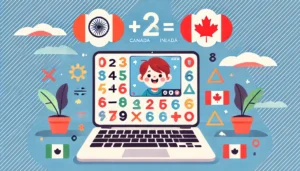
Grade 2 Math Syllabus (Canada)
Number Sense and Numeration
- Understanding numbers up to 100
- Counting by 1s, 2s, 5s, 10s, and 25s
- Introduction to even and odd numbers
- Addition and subtraction of two-digit numbers
- Introduction to simple multiplication (e.g., 2 × 3) and division concepts
- Problem-solving involving addition, subtraction, and basic multiplication
Geometry and Spatial Sense
- Identifying and describing common 2D shapes (circle, triangle, rectangle, square, hexagon)
- Recognizing 3D shapes (cube, sphere, cylinder, cone)
- Understanding the concept of symmetry and completing symmetrical shapes
- Describing the position, direction, and movement of objects
Measurement
- Measuring length, width, and height using standard units (centimeters, meters)
- Understanding and using the concept of time (hours, minutes, calendar months)
- Comparing and ordering objects based on weight, length, and capacity
- Introduction to money: recognizing and counting coins and bills, solving money problems
Patterning and Algebra
- Identifying, extending, and creating patterns (repeating and growing patterns)
- Exploring number patterns and simple number sequences
- Understanding equality and inequality (e.g., 10 > 8, 7 = 7)
- Introduction to the concept of variables through patterns
Data Management and Probability
- Collecting and organizing data using tallies and charts
- Reading and interpreting simple bar graphs and pictographs
- Describing and predicting the likelihood of events (e.g., “likely,” “unlikely,” “certain”)
Grade 3 Math Syllabus for Canada: Online Tutoring for Canada from India
Noble Learners is here to provide high-quality online tutoring for Canada from India, specifically designed to meet the needs of Grade 3 students. Our experienced tutors ensure that students are fully supported as they explore more advanced math concepts. By offering personalized, one-on-one lessons, we aim to build a strong mathematical foundation, enabling students to develop essential problem-solving skills while fostering a love for learning.
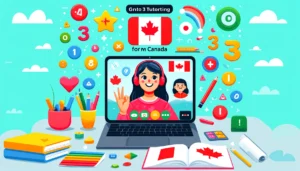
Grade 3 Math Syllabus (Canada)
Number Sense and Numeration
- Understanding numbers up to 1,000
- Skip counting by 2s, 5s, 10s, and 25s
- Rounding numbers to the nearest 10 or 100
- Addition and subtraction of 3-digit numbers with regrouping
- Introduction to multiplication and division (e.g., multiplication tables up to 5, basic division facts)
- Introduction to fractions (e.g., representing fractions as part of a whole, comparing fractions)
- Understanding place value (hundreds, tens, ones)
Geometry and Spatial Sense
- Identifying and describing common 2D shapes (e.g., triangles, quadrilaterals, pentagons)
- Recognizing and describing 3D shapes (e.g., cubes, spheres, cylinders)
- Introduction to angles (right angles, greater than/less than a right angle)
- Symmetry: identifying lines of symmetry in 2D shapes
- Describing and understanding transformations (slides, flips, turns)
- Exploring positions using simple grid systems (basic introduction to coordinates)
Measurement
- Measuring length, width, and height using standard units (centimeters, meters)
- Understanding the concept of area and perimeter (measuring and calculating for simple shapes)
- Measuring weight and capacity using standard units (grams, kilograms, liters)
- Telling time to the nearest minute using analog and digital clocks
- Solving problems involving money (e.g., adding and subtracting amounts, making change)
- Understanding and comparing temperatures in Celsius
Patterning and Algebra
- Recognizing and extending patterns (e.g., number patterns, shape patterns)
- Identifying growing and shrinking patterns and determining the rule
- Introduction to simple algebraic thinking (e.g., finding missing numbers in equations like 3 + _ = 7)
- Understanding simple sequences and predicting future terms in number patterns
- Using addition, subtraction, multiplication, and division to solve problems involving patterns
Data Management and Probability
- Collecting, organizing, and displaying data using charts and tables
- Reading and interpreting bar graphs and pictographs
- Conducting simple surveys and experiments to gather data
- Introduction to basic probability concepts (e.g., understanding “possible,” “impossible,” “certain” outcomes)
- Predicting outcomes based on data and understanding the concept of fairness in probability
Problem Solving and Reasoning
- Solving word problems using addition, subtraction, multiplication, and division
- Applying math concepts to real-world situations (e.g., money problems, measurement scenarios)
- Using critical thinking and reasoning to solve multi-step math problems
- Estimating answers and checking for reasonableness of results
- Working with visual tools (e.g., number lines, graphs) to aid in problem-solving
Grade 4 Math Syllabus for Canada: Online Tutoring for Canada from India
Noble Learners is your trusted platform for online tutoring for Canada from India, offering specialized instruction tailored to meet the needs of Grade 4 students. Our experienced tutors are well-versed in the Canadian curriculum, helping students grasp more complex math concepts while building confidence and problem-solving skills. Through one-on-one interactive sessions, we ensure that students receive personalized attention, making learning math a fun and rewarding experience.

Grade 4 Math Syllabus (Canada)
Number Sense and Numeration
- Understanding numbers up to 10,000
- Reading, writing, and representing large numbers
- Place value concepts (thousands, hundreds, tens, ones)
- Addition and subtraction of multi-digit numbers
- Multiplication of 1-digit numbers by 2-digit numbers (e.g., 4 × 32)
- Introduction to division with remainders
- Understanding fractions (e.g., ½, ¼, ⅓) and decimals (e.g., tenths, hundredths)
- Simple problem-solving using the four operations (addition, subtraction, multiplication, division)
Geometry and Spatial Sense
- Identifying and classifying 2D shapes (e.g., quadrilaterals, pentagons, hexagons)
- Recognizing and describing 3D shapes (e.g., pyramids, prisms, spheres)
- Understanding the properties of shapes (sides, angles, symmetry)
- Identifying lines of symmetry and rotational symmetry
- Introduction to transformations (translations, rotations, and reflections)
- Describing positions using coordinates on a grid
Measurement
- Understanding and using standard units of measurement (centimeters, meters, kilometers)
- Converting between units of length, mass, and capacity
- Calculating the perimeter and area of regular and irregular shapes
- Measuring time intervals in hours and minutes
- Using money concepts to solve real-world problems (e.g., making change, adding up costs)
- Understanding the concept of temperature and reading thermometers (Celsius)
Patterning and Algebra
- Identifying and describing increasing and decreasing number patterns
- Extending patterns and predicting future terms
- Understanding the concept of variables (e.g., solving equations like 3 + x = 7)
- Introduction to simple algebraic expressions (e.g., 2n + 1)
- Solving one-step equations using addition and subtraction
Data Management and Probability
- Collecting, organizing, and displaying data using charts, tables, and graphs (e.g., bar graphs, line plots)
- Reading and interpreting data from graphs
- Conducting simple surveys and experiments to gather data
- Introduction to probability (e.g., understanding “likely,” “unlikely,” “certain” events)
- Solving probability problems and predicting outcomes
Problem Solving and Critical Thinking
- Engaging in real-world math problems that require critical thinking
- Applying logical reasoning to multi-step problems
- Solving word problems involving money, time, and measurement
- Using estimation and mental math strategies to solve problems efficiently
- Understanding and solving problems using visual aids like graphs and charts
Grade 5 Math Syllabus for Canada: Online Tutoring for Canada from India
At Noble Learners, we provide exceptional online tutoring for Canada from India to help Grade 5 students excel in mathematics. Our experienced tutors guide students through a comprehensive curriculum, focusing on enhancing problem-solving skills and a deeper understanding of key mathematical concepts. Through personalized, one-on-one sessions, students gain the confidence and knowledge they need to succeed in their academic journey.
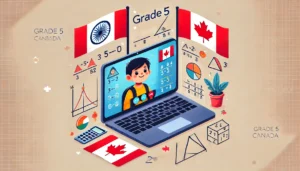
Grade 5 Math Syllabus (Canada)
Number Sense and Numeration
- Understanding numbers up to 100,000
- Comparing and ordering large numbers
- Introduction to prime and composite numbers
- Understanding place value (thousands, hundreds, tens, ones)
- Addition and subtraction of multi-digit numbers with regrouping
- Multiplication and division of larger numbers (up to 3-digit by 2-digit numbers)
- Working with fractions and mixed numbers (e.g., equivalent fractions, comparing and ordering fractions)
- Understanding decimals (up to hundredths) and rounding decimals
- Introduction to percentages (e.g., understanding basic percentages like 50%, 25%)
Geometry and Spatial Sense
- Identifying and classifying polygons (e.g., triangles, quadrilaterals, pentagons)
- Understanding angles (acute, obtuse, right angles) and measuring angles using a protractor
- Describing 3D shapes and their properties (e.g., faces, edges, vertices)
- Exploring symmetry, including rotational symmetry and lines of symmetry
- Understanding and performing transformations (translations, rotations, reflections)
- Introduction to the coordinate plane: plotting points on a grid using ordered pairs (x, y)
Measurement
- Converting units of measurement (e.g., millimeters to centimeters, grams to kilograms)
- Calculating the perimeter and area of regular and irregular shapes (e.g., rectangles, triangles)
- Measuring and calculating the volume of 3D objects (e.g., cubes, rectangular prisms)
- Solving time-related problems (e.g., elapsed time, reading schedules)
- Understanding and using money in problem-solving scenarios (e.g., budgeting, calculating totals)
- Measuring temperature and solving problems involving Celsius and Fahrenheit
Patterning and Algebra
- Recognizing and extending complex number patterns (e.g., geometric patterns, arithmetic sequences)
- Identifying pattern rules and using them to predict future terms
- Solving algebraic expressions involving variables (e.g., solving for x in 2x + 3 = 7)
- Introduction to simple algebraic equations and inequalities
- Applying patterns to real-life situations (e.g., predicting patterns in data sets)
Data Management and Probability
- Collecting and organizing data using frequency tables, line plots, and bar graphs
- Interpreting and analyzing data from various types of graphs (e.g., pie charts, line graphs)
- Calculating mean, median, and mode for a set of data
- Conducting surveys and experiments to gather data
- Exploring probability (e.g., understanding terms like “likely,” “unlikely,” “certain,” “impossible”)
- Solving basic probability problems using fractions and percentages
Problem Solving and Critical Thinking
- Applying mathematical concepts to real-world scenarios (e.g., using math in budgeting, shopping, and cooking)
- Solving multi-step word problems involving all four operations (addition, subtraction, multiplication, division)
- Developing estimation skills to check the reasonableness of answers
- Using mental math strategies for quick calculations
- Engaging in collaborative problem-solving activities that require logical thinking and reasoning
Grade 6 Math Syllabus for Canada: Online Tutoring for Canada from India
Noble Learners is proud to offer top-tier online tutoring for Canada from India, designed specifically to meet the needs of Grade 6 students. Our expert tutors provide personalized, one-on-one instruction that helps students develop advanced problem-solving skills and a deeper understanding of mathematical concepts. With our support, students are prepared to tackle complex math challenges with confidence and accuracy.

Grade 6 Math Syllabus (Canada)
Number Sense and Numeration
- Understanding numbers up to 1,000,000
- Identifying prime and composite numbers
- Understanding and applying place value (millions, thousands, hundreds, tens, ones)
- Multiplication and division of large numbers (up to 4-digit by 2-digit numbers)
- Working with fractions, decimals, and percentages (e.g., converting between fractions, decimals, and percentages)
- Operations with fractions (e.g., addition, subtraction, multiplication of fractions)
- Operations with decimals (e.g., adding, subtracting, multiplying, and dividing decimals)
- Introduction to ratios and proportional relationships
Geometry and Spatial Sense
- Classifying and describing 2D shapes and polygons (e.g., parallelograms, trapezoids, regular polygons)
- Exploring the properties of 3D shapes (e.g., cubes, prisms, pyramids) and calculating surface area and volume
- Understanding and measuring angles (e.g., complementary, supplementary, angles in triangles)
- Using protractors to measure and construct angles
- Understanding symmetry, transformations (translations, rotations, reflections), and congruence
- Plotting points on the Cartesian coordinate plane and interpreting coordinates in all four quadrants
Measurement
- Converting between metric units of length, mass, and volume (e.g., millimeters to meters, grams to kilograms)
- Calculating perimeter, area, and volume of regular and irregular shapes
- Solving problems involving elapsed time and reading schedules
- Using formulas to calculate the area of triangles, parallelograms, and trapezoids
- Working with metric and imperial units in real-world contexts (e.g., temperature conversions, distances)
- Calculating and solving problems involving money, including budgeting and financial planning
Patterning and Algebra
- Identifying and extending complex numerical and geometric patterns
- Exploring algebraic expressions, equations, and inequalities
- Solving for unknown variables in simple algebraic equations (e.g., 4x + 5 = 21)
- Understanding relationships between variables in patterns and equations
- Using variables to represent and solve real-life problems
- Graphing linear relationships on a coordinate plane
Data Management and Probability
- Collecting, organizing, and interpreting data from surveys and experiments
- Displaying data using histograms, pie charts, and line graphs
- Calculating mean, median, mode, and range for data sets
- Conducting experiments and determining experimental probability
- Exploring theoretical probability and solving probability problems using fractions, decimals, and percentages
- Understanding and interpreting probability in real-world contexts (e.g., weather forecasting, games of chance)
Problem Solving and Critical Thinking
- Tackling multi-step word problems that require the use of all four operations (addition, subtraction, multiplication, and division)
- Solving problems related to time, money, measurement, and geometry in real-life scenarios
- Developing and applying estimation and mental math strategies to quickly solve problems
- Engaging in mathematical reasoning to solve complex, open-ended problems
- Using charts, graphs, and other visual tools to solve problems and explain solutions clearly
- Applying math concepts to science, technology, and everyday life (e.g., measuring in cooking, using ratios in art)
Grade 7 Math Syllabus for Canada: Online Tutoring for Canada from India
At Noble Learners, our online tutoring for Canada from India is designed to cover the comprehensive Grade 7 Math curriculum. Our experienced tutors provide personalized, one-on-one tutoring, ensuring that students grasp critical concepts and excel in their studies.
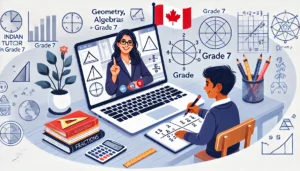
Grade 7 Math Syllabus (Canada)
Number Sense and Numeration
- Working with integers: addition, subtraction, multiplication, and division of positive and negative numbers
- Prime factorization and understanding greatest common factors (GCF) and least common multiples (LCM)
- Operations with fractions and decimals, including multiplication and division
- Comparing and ordering fractions, decimals, and percents
- Introduction to square roots and perfect squares
- Ratio, rate, and proportional reasoning
Measurement
- Converting between different units of measurement (metric and imperial systems)
- Calculating the perimeter and area of composite shapes
- Introduction to surface area and volume of rectangular prisms, cubes, and triangular prisms
- Solving problems involving time, distance, and speed
- Using formulas to calculate area and volume in real-life contexts
Geometry
- Identifying and classifying different types of triangles and quadrilaterals
- Working with angles, including complementary, supplementary, and opposite angles
- Constructing geometric figures using a protractor and ruler
- Introduction to transformations (reflections, rotations, translations) on a coordinate plane
- Exploring symmetry and congruence in shapes
- Understanding the properties of parallel and perpendicular lines
Patterning and Algebra
- Identifying and extending patterns in tables, diagrams, and sequences
- Introduction to algebraic expressions and equations
- Solving simple one-step and two-step equations using inverse operations
- Understanding the distributive property and simplifying expressions
- Graphing simple linear equations on the coordinate plane
- Using variables to solve real-world problems
Data Management and Probability
- Collecting, organizing, and interpreting data using charts, graphs, and tables
- Reading and analyzing bar graphs, histograms, and line graphs
- Calculating mean, median, mode, and range
- Conducting simple probability experiments and understanding theoretical probability
- Solving probability problems using fractions, decimals, and percents
- Exploring probability in everyday situations (e.g., games, weather forecasts)
Financial Literacy
- Understanding the value of money, budgeting, and financial decision-making
- Solving real-life problems involving taxes, discounts, and simple interest
- Exploring concepts related to earning, saving, and spending money
- Calculating unit costs and comparing products based on price
Grade 8 Math Syllabus for Canada: Online Tutoring for Canada from India
At Noble Learners, we specialize in offering high-quality online tutoring for Canada from India. Our experienced tutors help students master the Grade 8 Math syllabus, ensuring a deep understanding of critical concepts and building the skills necessary for success. With one-on-one attention, our tutoring is tailored to meet each student’s unique needs.

Grade 8 Math Syllabus (Canada)
Number Sense and Numeration
- Working with large numbers and integers: addition, subtraction, multiplication, and division of positive and negative numbers
- Understanding rational numbers (fractions and decimals), and performing operations with them
- Exploring exponents and powers: understanding and calculating powers of whole numbers
- Square roots and estimating square roots of non-perfect squares
- Ratios, rates, and proportional reasoning (e.g., solving real-world problems with proportions)
- Solving percent-related problems (e.g., discounts, interest, taxes)
- Understanding and applying the order of operations (BEDMAS)
Geometry and Spatial Sense
- Identifying and classifying polygons (e.g., triangles, quadrilaterals) and their properties
- Measuring angles in polygons and understanding the sum of interior angles
- Understanding and calculating the surface area and volume of 3D shapes (e.g., prisms, cylinders)
- Working with transformations: translations, rotations, reflections, and dilations on a Cartesian plane
- Using the Pythagorean Theorem to solve problems involving right-angled triangles
- Graphing and plotting coordinates in all four quadrants of the Cartesian plane
Measurement
- Converting between different units of measurement (metric and imperial systems)
- Calculating perimeter, area, and volume for 2D and 3D shapes, including composite figures
- Solving real-world problems involving distance, time, speed, and scale
- Using formulas to calculate the surface area and volume of prisms and cylinders
- Understanding rates of change in relation to measurement problems (e.g., speed = distance/time)
Patterning and Algebra
- Identifying, extending, and creating algebraic patterns
- Understanding algebraic expressions, simplifying expressions, and solving equations
- Solving one-step and two-step linear equations and inequalities
- Using variables to represent numbers in equations and solve real-life problems
- Introduction to linear relations: graphing and interpreting linear relationships
- Working with slope and y-intercept in the context of linear equations
Data Management and Probability
- Collecting, organizing, and analyzing data using frequency tables and graphs (e.g., bar graphs, line graphs, histograms)
- Calculating mean, median, mode, and range for a given data set
- Interpreting and drawing conclusions from data presented in various formats
- Understanding probability concepts: theoretical vs. experimental probability
- Solving probability problems involving independent and dependent events
- Representing probabilities as fractions, decimals, and percentages
Financial Literacy
- Understanding income, expenses, savings, and budgeting
- Solving problems related to financial transactions, including taxes, discounts, and interest rates
- Exploring concepts of simple and compound interest in savings and loans
- Introduction to personal financial management, including banking and credit
Grade 9 Math Syllabus for Canada: Online Tutoring for Canada from India
At Noble Learners, we offer expert online tutoring for Canada from India to help students tackle the more challenging concepts of the Grade 9 Math curriculum. Grade 9 is a pivotal year where students transition into more advanced topics and mathematical reasoning. Our one-on-one tutoring sessions ensure that students receive the individualized support they need to succeed.

Grade 9 Math Syllabus (Canada)
Number Sense and Numeration
- Working with rational and irrational numbers: distinguishing between rational and irrational numbers (e.g., square roots of non-perfect squares, π)
- Understanding real numbers and performing operations with them (addition, subtraction, multiplication, and division)
- Simplifying and operating with radicals (e.g., square roots, cube roots)
- Using exponents and powers, including working with negative and fractional exponents
- Solving problems involving scientific notation and very large/small numbers
- Understanding and applying the laws of exponents to simplify expressions
- Order of operations (BEDMAS) with complex expressions involving exponents and radicals
Polynomials and Algebra
- Identifying and classifying polynomials (e.g., monomials, binomials, trinomials)
- Adding, subtracting, multiplying, and dividing polynomials
- Simplifying polynomial expressions
- Introduction to factoring polynomials (e.g., common factoring, factoring trinomials)
- Solving polynomial equations using various factoring methods (e.g., difference of squares)
- Introduction to algebraic fractions: simplifying and performing operations with algebraic fractions
- Solving word problems involving polynomials and algebraic expressions
Linear Relations and Functions
- Understanding linear relations and recognizing them in tables, graphs, and equations
- Graphing linear equations and interpreting the slope and y-intercept
- Understanding the slope of a line as a rate of change (rise over run)
- Writing equations of lines in slope-intercept form (y = mx + b), point-slope form, and general form
- Solving systems of linear equations graphically and algebraically (substitution and elimination methods)
- Introduction to functions: understanding the concept of a function, function notation, and evaluating functions
- Investigating direct and partial variation in real-world contexts
Measurement and Geometry
- Working with the Pythagorean Theorem: solving for unknown sides in right-angled triangles
- Solving problems involving the properties of triangles and quadrilaterals (e.g., congruence, similarity)
- Understanding circle geometry: angles in circles, chords, tangents, and arc lengths
- Calculating surface area and volume of composite 3D shapes (e.g., prisms, cylinders, spheres, cones)
- Solving problems involving the surface area and volume of irregular shapes
- Working with trigonometry: using sine, cosine, and tangent ratios to solve right triangle problems
- Introduction to basic transformations (translations, rotations, reflections, dilations) on a Cartesian plane
Quadratic Relations
- Understanding quadratic functions and their graphs (parabolas)
- Identifying the key features of quadratic graphs: vertex, axis of symmetry, direction of opening, and intercepts
- Writing equations of quadratic functions in standard form (y = ax² + bx + c)
- Solving quadratic equations by factoring, completing the square, and using the quadratic formula
- Graphing quadratic functions and solving real-life problems involving quadratics
- Investigating the properties of parabolas and their applications in real-world contexts (e.g., projectile motion)
Data Management and Probability
- Collecting, organizing, and interpreting data using frequency tables, histograms, and scatter plots
- Calculating measures of central tendency (mean, median, mode) and measures of spread (range, interquartile range, standard deviation)
- Introduction to bivariate data: identifying and interpreting positive and negative correlations
- Solving problems involving probability, including independent and dependent events
- Understanding compound probability and using tree diagrams to calculate probabilities
- Investigating permutations and combinations to solve counting problems
- Applying probability concepts to real-world situations (e.g., genetics, games, decision-making)
Financial Literacy
- Understanding personal finances: income, budgeting, and saving
- Solving problems related to interest rates, including simple and compound interest
- Exploring investments: understanding concepts like loans, mortgages, credit cards, and debt management
- Introduction to financial decision-making and long-term planning (e.g., investments, retirement planning)
- Analyzing the impact of taxes, discounts, and inflation on personal finances
Advanced Algebra and Problem Solving
- Working with rational expressions: simplifying, multiplying, dividing, adding, and subtracting
- Solving rational equations and applying them to real-world scenarios
- Introduction to absolute value and solving absolute value equations
- Investigating more complex algebraic problems that involve multiple steps and algebraic reasoning
- Solving multi-step word problems that require critical thinking and the application of multiple math concepts
Grade 10 Math Syllabus for Canada: Online Tutoring for Canada from India
Noble Learners provides specialized online tutoring for Canada from India, focusing on the comprehensive Grade 10 Math curriculum. Grade 10 is a critical year for students, as they delve into advanced algebra, functions, geometry, and more complex topics in preparation for higher-level math courses. Our personalized one-on-one tutoring sessions ensure that students fully understand these key concepts.

Grade 10 Math Syllabus (Canada)
Quadratic Functions
- Exploring the properties of quadratic functions and their graphs (parabolas)
- Identifying the vertex, axis of symmetry, and direction of opening of a parabola
- Writing quadratic functions in standard, vertex, and factored forms
- Solving quadratic equations by factoring, completing the square, and using the quadratic formula
- Graphing quadratic functions and interpreting the solutions in real-world contexts (e.g., projectile motion)
Exponents and Exponential Functions
- Reviewing the laws of exponents for integer, fractional, and negative exponents
- Understanding exponential growth and decay
- Solving problems involving exponential growth/decay (e.g., population growth, depreciation)
- Graphing exponential functions and analyzing their key features
- Comparing linear, quadratic, and exponential functions in real-world applications
Linear Systems
- Solving systems of linear equations graphically and algebraically (substitution, elimination)
- Investigating the relationships between two linear equations (e.g., parallel, intersecting, or coincident lines)
- Applying linear systems to solve real-life problems involving two variables
- Analyzing the intersection points of linear and quadratic functions
Polynomials
- Understanding the degree and classification of polynomials
- Performing operations with polynomials (addition, subtraction, multiplication, and division)
- Factoring polynomials (e.g., common factoring, difference of squares, trinomial factoring)
- Solving polynomial equations by factoring and applying them to real-life problems
- Exploring the relationships between the factors and zeros of a polynomial
Trigonometry
- Using the primary trigonometric ratios (sine, cosine, tangent) to solve right-angled triangles
- Applying the Pythagorean Theorem in trigonometric contexts
- Solving real-world problems involving angles of elevation and depression
- Introduction to the sine and cosine laws for non-right-angled triangles
- Solving word problems involving triangles and interpreting the results in various applications
Geometry
- Investigating the properties of similar and congruent triangles
- Proving geometric theorems related to angles, lines, and triangles
- Exploring properties of circles (e.g., central angles, inscribed angles, chords, tangents)
- Working with coordinate geometry: determining the distance between points, midpoint, and slope of a line segment
- Analyzing geometric transformations (translations, rotations, reflections, dilations) on the coordinate plane
Rational Expressions and Equations
- Simplifying rational expressions and solving rational equations
- Adding, subtracting, multiplying, and dividing rational expressions
- Understanding and applying the concept of excluded values in rational expressions
- Solving word problems involving rational equations in real-life contexts
Measurement and Surface Area
- Calculating surface area and volume of 3D shapes, including spheres, cones, and pyramids
- Solving problems involving composite 3D shapes
- Applying measurement concepts to real-life situations (e.g., packaging, architecture)
- Understanding the relationships between different units of measurement (metric and imperial)
Probability and Statistics
- Exploring theoretical and experimental probability in single and multi-step experiments
- Calculating compound probabilities using independent and dependent events
- Applying probability concepts to real-world scenarios (e.g., gambling, insurance)
- Introduction to statistics: collecting, organizing, and interpreting data
- Solving problems using measures of central tendency (mean, median, mode) and spread (range, standard deviation)
Functions and Relations
- Understanding the concept of a function and function notation
- Exploring the differences between linear, quadratic, and exponential functions
- Analyzing domain and range of functions
- Graphing and interpreting functions using various forms (e.g., table of values, equations)
- Solving real-life problems involving functions (e.g., finance, business)
Financial Mathematics
- Solving problems involving compound interest, loans, and annuities
- Understanding the mathematics of personal finance, including taxes, budgets, and investments
- Calculating interest rates and understanding different types of loans
- Applying mathematical concepts to real-life financial decision-making scenarios
Advanced Algebra
- Working with radicals and simplifying radical expressions
- Solving radical equations and applying them to real-world problems
- Solving systems involving quadratic and linear equations
- Investigating the use of algebraic models to represent real-world scenarios
Grade 11 Math Syllabus for Canada: Online Tutoring for Canada from India
Noble Learners offers specialized online tutoring for Canada from India for Grade 11 students, covering the full range of topics in this crucial year of math education. Grade 11 introduces students to advanced concepts that are fundamental to higher education and STEM-related careers. Our personalized tutoring ensures students understand these concepts thoroughly, allowing them to build a strong mathematical foundation.

Grade 11 Math Syllabus (Canada)
Advanced Functions
- Understanding the concept of a function, domain, and range
- Investigating linear, quadratic, polynomial, rational, and exponential functions
- Operations with functions: addition, subtraction, multiplication, division, and composition of functions
- Graphing functions and analyzing their properties (e.g., intercepts, asymptotes, end behavior)
- Solving problems involving inverse functions and understanding their relationships with original functions
Quadratic Functions
- Graphing quadratic functions in vertex, factored, and standard forms
- Completing the square to convert quadratic functions to vertex form
- Solving quadratic equations using factoring, the quadratic formula, and completing the square
- Analyzing the properties of parabolas (vertex, axis of symmetry, direction of opening)
- Solving real-world problems involving quadratic models (e.g., projectile motion, optimization problems)
Polynomial Functions
- Investigating the characteristics of polynomial functions of different degrees
- Performing operations with polynomials: addition, subtraction, multiplication, and division
- Factoring polynomials using methods like grouping, synthetic division, and long division
- Finding the zeros of polynomial functions and relating them to their factors
- Graphing polynomial functions and analyzing their key features (e.g., turning points, end behavior)
Rational Functions
- Simplifying rational expressions and performing operations with them (addition, subtraction, multiplication, division)
- Graphing rational functions and analyzing asymptotes, discontinuities, and intercepts
- Solving rational equations and inequalities
- Applying rational functions to model real-world problems
- Investigating the behavior of rational functions near vertical and horizontal asymptotes
Exponential and Logarithmic Functions
- Exploring exponential growth and decay, and graphing exponential functions
- Understanding and applying the laws of exponents
- Solving exponential equations and logarithmic equations
- Investigating the properties of logarithmic functions and their inverse relationship with exponential functions
- Applying logarithmic and exponential functions to solve real-world problems (e.g., population growth, radioactive decay)
Trigonometric Functions
- Investigating the properties of sine, cosine, and tangent functions
- Understanding the unit circle and the relationships between angles and trigonometric ratios
- Graphing trigonometric functions and analyzing their amplitude, period, and phase shift
- Solving trigonometric equations and verifying identities
- Applying trigonometry to solve real-world problems involving angles, distances, and circular motion
Solving Systems of Equations
- Solving systems of linear and non-linear equations algebraically (substitution, elimination) and graphically
- Investigating the solutions of systems involving quadratic, polynomial, and rational functions
- Applying systems of equations to solve real-life problems in business, engineering, and science
Sequences and Series
- Investigating arithmetic sequences and series: finding the general term, sum of the first n terms
- Investigating geometric sequences and series: calculating terms, sum of finite and infinite series
- Applying sequences and series to model and solve real-world problems (e.g., finance, physics)
Vectors and Geometry
- Understanding vectors in two-dimensional space: magnitude, direction, and components
- Performing operations with vectors: addition, subtraction, scalar multiplication
- Exploring applications of vectors in geometry and physics
- Solving problems involving vectors, such as displacement, velocity, and force
Analytic Geometry
- Investigating the equations of lines, circles, and parabolas in the coordinate plane
- Solving problems involving distance, midpoint, and slope in the context of lines and curves
- Exploring conic sections: parabolas, ellipses, and hyperbolas
- Applying analytic geometry to model and solve problems in science and engineering
Permutations and Combinations
- Understanding the fundamental principle of counting
- Investigating permutations and combinations and their applications to probability
- Solving problems involving arrangements, selections, and groupings
- Applying permutations and combinations to real-life scenarios (e.g., lotteries, seating arrangements)
Probability and Statistics
- Investigating probability rules for independent and dependent events
- Solving problems involving conditional probability and the law of total probability
- Exploring binomial probability distributions and solving related problems
- Understanding the concept of statistical sampling and how data can be interpreted using statistical tools
- Calculating measures of central tendency (mean, median, mode) and dispersion (range, standard deviation)
Financial Mathematics
- Solving problems involving simple and compound interest
- Understanding annuities, loans, and amortization schedules
- Investigating real-world financial scenarios, such as mortgage payments, investments, and savings plans
- Analyzing the impact of interest rates and inflation on personal finance
Matrices and Determinants
- Understanding the basic concepts of matrices and determinants
- Performing operations with matrices (addition, subtraction, multiplication)
- Solving systems of linear equations using matrix methods (Gaussian elimination, inverse matrices)
- Applying matrices to model and solve real-life problems (e.g., economics, cryptography)
Conics
- Exploring the properties of conic sections (parabolas, ellipses, hyperbolas)
- Writing the equations of conic sections in standard form
- Solving problems involving the intersection of conic sections and lines
- Applying conics to solve problems in physics, astronomy, and engineering
Transformations
- Investigating geometric transformations: translations, rotations, reflections, dilations
- Understanding the concept of transformations in function graphs
- Exploring the effects of transformations on functions and their equations
- Applying transformations in real-world contexts such as art, design, and physics
Logarithmic and Exponential Applications
- Applying logarithmic and exponential models to solve problems in finance, biology, and chemistry
- Solving compound interest and population growth problems using exponential models
- Exploring the application of logarithms in pH, Richter scale, and decibels
Inequalities
- Solving and graphing linear and quadratic inequalities
- Solving systems of inequalities and interpreting their solutions graphically
- Applying inequalities to real-world problems (e.g., optimization problems)
Optimization
- Using calculus-free methods (such as completing the square) to solve optimization problems
- Investigating maximum and minimum values of functions in real-life scenarios (e.g., business, engineering)
Transformational Geometry
- Using transformational geometry concepts to investigate patterns and tessellations
- Solving real-world problems involving symmetry, transformations, and geometry
Grade 12 Math Syllabus for Canada: Online Tutoring for Canada from India
Noble Learners offers comprehensive online tutoring for Canada from India tailored for Grade 12 students. Grade 12 Mathematics represents the final stage of high school math education and covers advanced concepts that are crucial for students preparing for university programs, particularly in STEM fields. Our tutoring ensures that students understand these topics in depth and are well-prepared for higher education.
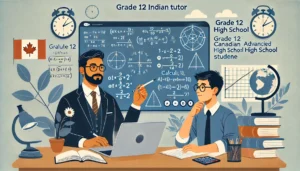
Grade 12 Math Syllabus (Canada)
Advanced Functions
- Understanding the behavior of polynomial, rational, exponential, logarithmic, and trigonometric functions
- Investigating transformations of functions: translations, stretches, compressions, and reflections
- Solving problems involving combinations of functions, including sums, products, quotients, and compositions
- Analyzing the properties of functions, including asymptotes, intercepts, domain, and range
- Solving equations and inequalities involving advanced functions
Exponential and Logarithmic Functions
- Solving exponential equations using logarithms
- Applying laws of logarithms to simplify expressions and solve problems
- Investigating real-world applications of exponential growth and decay, such as compound interest and population growth
- Graphing exponential and logarithmic functions, analyzing asymptotes, and understanding their transformations
Trigonometry and Trigonometric Functions
- Investigating the unit circle and applying it to trigonometric functions
- Solving trigonometric equations and inequalities
- Graphing and analyzing trigonometric functions (sine, cosine, tangent) and their transformations
- Understanding the properties of sinusoidal functions and applying them to model periodic phenomena (e.g., sound waves, tides)
- Exploring advanced trigonometric identities, including sum and difference formulas, double-angle, and half-angle identities
- Solving problems using the sine and cosine laws in non-right triangles
Calculus (Introduction)
- Understanding limits and their applications in calculus
- Investigating the concept of continuity and how it relates to limits
- Introduction to derivatives: definition and interpretation of the derivative as a rate of change
- Differentiating polynomial, rational, exponential, and trigonometric functions
- Applying derivatives to solve problems involving optimization, motion, and rates of change
- Understanding the concept of the integral and its relationship to the area under a curve
Vectors and 3D Geometry
- Understanding vectors in two and three dimensions: magnitude, direction, and components
- Performing operations with vectors: addition, subtraction, dot product, cross product
- Solving geometric problems involving vectors (e.g., lines, planes, angles between planes)
- Investigating vector applications in physics, engineering, and navigation
- Solving problems involving vector equations of lines and planes in 3D
Advanced Polynomial Functions
- Investigating higher-degree polynomial functions and their properties (e.g., end behavior, turning points, zeros)
- Solving higher-degree polynomial equations using factoring, synthetic division, and the Rational Root Theorem
- Graphing polynomial functions and analyzing their critical points
- Applying polynomial models to real-life problems (e.g., optimization, finance)
Rational Functions
- Analyzing the properties of rational functions: asymptotes, intercepts, domain, and range
- Graphing rational functions and solving rational equations
- Solving inequalities involving rational functions
- Applying rational functions to model and solve problems in real-world scenarios
Sequences and Series
- Investigating arithmetic and geometric sequences and series
- Using formulas to find the sum of finite and infinite geometric series
- Solving real-world problems involving sequences and series (e.g., loan amortization, population growth)
- Exploring more advanced series concepts such as sigma notation and recursive sequences
Combinatorics
- Understanding the fundamental principle of counting, permutations, and combinations
- Solving problems involving arrangements, selections, and groupings
- Applying combinatorial techniques to solve probability problems and real-world situations (e.g., scheduling, inventory management)
- Investigating the binomial theorem and its applications
Probability and Statistics
- Investigating probability distributions, including binomial and normal distributions
- Solving problems involving discrete and continuous probability distributions
- Calculating expected value and standard deviation in various contexts
- Understanding and applying conditional probability and Bayes’ Theorem
- Solving problems using probability concepts in real-world applications (e.g., risk analysis, insurance)
Limits and Continuity (Advanced)
- Investigating limits from the perspective of approaching specific points and infinity
- Understanding how limits define continuity of functions
- Solving problems involving infinite limits and limits at infinity
- Applying limits in preparation for more advanced calculus topics
Differentiation (Advanced)
- Understanding the rules of differentiation: product rule, quotient rule, and chain rule
- Applying derivatives to solve complex optimization problems in various fields (e.g., physics, economics)
- Investigating related rates problems where two or more variables change with respect to time
- Using higher-order derivatives to analyze concavity and inflection points
Integration (Introduction)
- Understanding the definite and indefinite integrals
- Calculating areas under curves using integration
- Investigating the relationship between differentiation and integration (Fundamental Theorem of Calculus)
- Solving basic problems involving integrals in real-world contexts (e.g., area, volume, displacement)
Financial Mathematics
- Solving complex problems involving compound interest, annuities, and amortization
- Investigating real-world financial models, including loans, investments, and savings plans
- Applying calculus concepts to optimize financial decision-making (e.g., maximizing returns, minimizing costs)
- Analyzing the effect of inflation, interest rates, and taxes on personal finance
Transformations of Functions
- Investigating the effects of transformations (shifts, stretches, reflections) on the graphs of various functions
- Applying transformations to model and solve real-world problems
- Solving problems involving the combination of multiple transformations on polynomial, rational, and trigonometric functions
Systems of Equations and Inequalities
- Solving systems of linear and nonlinear equations using algebraic and graphical methods
- Investigating systems of inequalities and interpreting their solutions graphically
- Applying systems of equations and inequalities to real-world problems in economics, engineering, and optimization
Matrix Algebra
- Understanding matrices and performing operations on them (addition, multiplication, inverses)
- Solving systems of linear equations using matrix methods (Gaussian elimination, Cramer’s Rule)
- Investigating real-life applications of matrices in fields like economics, cryptography, and computer graphics
Conic Sections
- Exploring the properties of parabolas, ellipses, and hyperbolas
- Investigating the equations of conic sections and their geometric properties
- Solving real-world problems involving conic sections (e.g., satellite dishes, planetary orbits)
- Applying calculus to analyze conic sections in preparation for advanced studies in geometry
Vector Calculus (Introduction)
- Investigating vector-valued functions and their applications
- Understanding the concept of gradient and directional derivatives
- Solving real-world problems involving vector fields (e.g., fluid dynamics, electromagnetism)
Optimization in Calculus
- Using derivatives to solve optimization problems in various real-world contexts (e.g., maximizing profit, minimizing cost)
- Investigating constraints in optimization problems using Lagrange multipliers (introduction)
- Applying optimization techniques to fields like economics, engineering, and biology
